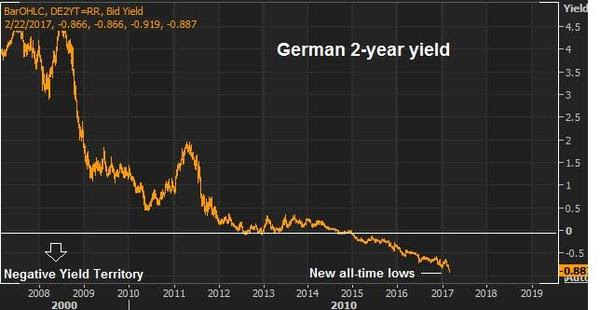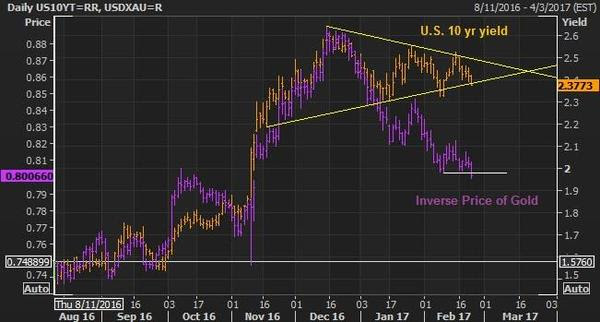February 23, 2017, 4:30pm EST Invest Alongside Billionaires For $297/Qtr

Yesterday we talked about the warning signal flashing from the German bond market. That continues today.
While global stocks and commodities are reflecting broad optimism about the new pro-growth government in the U.S., the yield on 2-year German government bonds is sending a negative message — it hit record lows yesterday, and again today — trading to negative 90 basis points. You pay almost 1% to loan the German government money for two years.
Here’s a longer term look at German yields, for perspective…

And here’s the divergence since the election between German and U.S. 2 year yields…

This divergence is partially driven by rising U.S. yields on optimism about the outlook, about inflationary policies, and about the Fed’s response. On the other hand, German yields have gone the other way because 1) the ECB is still outright buying government bonds through its QE program (bond prices go up, yields go down), and 2) capital flows into bonds, in search of safety, because a Trump win makes another populist vote in Europe more likely when the French elections role around in May.
So that bleed to new lows in the German 2-year yield sends a warning signal to global markets. Today we have a few more reasons to think this could be a signal that the optimism being priced into U.S. markets at the moment could take a breather here.
Trump’s Secretary of Treasury, Mnuchin, was doing his first rounds on financial TV this morning and gave us some guidance on a timeline for policies and impact. Most importantly, he says we’ll see limited impact from Trump policies in 2017, and that the growth impact won’t come until 2018.
Let’s consider how that can impact where the Fed stands on their forecasts for monetary policy.
Remember, they spent the better part of 2016 walking back on the promises they had made for 4 rate hikes last year. And then, when they finally moved for thefirst time this past December, following the election and a rallying stock market, they reversed course on all of the dovish talk of the past months, and re-upped on another big rate hiking plan for 2017.
Though they don’t like to admit it, we can only assume that when they considered a massive fiscal stimulus package coming, like any human would, they became more bullish on the economy and more hawkish on the inflation outlook.
So now as Mnuchin tells us not to expect a growth impact from Trump policies until next year, maybe the Fed lays off the tightening rhetoric for a while.
With all of this in mind, another interesting dynamic in markets today, the Dow shrugged off some weakness early on to trade higher most of the day, posting another new record high. Meanwhile small caps diverged, trading weaker all day. And gold traded to the highest level since November 11. Remember this chart we’ve looked at, which looks like higher gold to come (a lower purple line), and lower yields.

This would all project a calming for the inflation outlook, which would be good for the health of markets. Among the biggest risk to Trumponomics is hot inflation, too fast, and a race higher in interest rates to chase it.
To peek inside the portfolio of Trump’s key advisor, join me in our Billionaire’s Portfolio. When you do, I’ll send you my special report with all of the details on Icahn, and where he’s investing his multibillion-dollar fortune to take advantage of Trump policies. Click here to join now.
June 2, 2016, 3:25pm EST
 In the middle of June we have perhaps the two biggest events of the year. On June 15 the Fed will decide on rates. And hours later, that Wednesday night, the Bank of Japan will follow with its decision on policy.
In the middle of June we have perhaps the two biggest events of the year. On June 15 the Fed will decide on rates. And hours later, that Wednesday night, the Bank of Japan will follow with its decision on policy.
This is really the perfect scenario for the Fed. The biggest impediment in its hiking cycle/”rate normalization process” is instability in global financial markets. Market reactions can lead to damage to consumer sentiment, capital flight and tightening in credit—all the things that can spawn the threat of a global economic shock, which can derail global recovery. Clearly, they are very sensitive to that. On that note, the Brexit risk, while a hot topic in the news, is priced by experts as a low probability.
So, the Fed has been setting expectations that a second hike in its tightening cycle could be coming this month. But the market isn’t listening. The market is pricing in just a 23% chance of a hike in June. But as we’ve said, markets can get it wrong, sometimes very wrong. We think they have it wrong this time. We think there is a much better chance. Why? Because they know the BOJ is right behind them. If they do hike, any knee jerk hit to financial markets can be quelled by more easing from the BOJ.
Remember, as we’ve discussed quite a bit in our daily notes, central banks remain in control. The recovery was paid for by a highly concerted effort by the world’s top economic powers and central banks. And despite the perceived hostility over currency manipulation, the powers of the world understand that the U.S. is leading the way out of recovery, and that Europe and Japan are critical pieces in the global recovery. The ECB and BOJ have been passed the QE torch from the Fed to both fuel recovery and promote global economic stability. And playing a major role in that effort is a weaker euro and a weaker yen.
The Bank of Japan is operating with one target in mind, create inflation. Now three years into their massive program, they haven’t posted a positive monthly inflation number since December. Inflation is still dead, just as it has been for the past two decades. So, not only do they have the appetite and global support to do more, but the data more than justifies more action.
Don’t Miss Out On This Stock
In our Billionaire’s Portfolio we followed the number one performing hedge fund on the planet into a stock that has the potential to triple by the end of next month.
This fund returned an incredible 52% last year, while the S&P 500 was flat. And since 1999, they’ve done 40% a year. And they’ve done it without one losing year. For perspective, that takes every $100,000 to $30 million.
We want you on board. To find out the name of this hedge fund, the stock we followed them into, and the catalyst that could cause the stock to triple by the end of the month, click here and join us in our Billionaire’s Portfolio.
We make investing easy. We follow the guys with the power and the influence to control their own destiny – and a record of unmatchable success. And you come along for the ride.
We look forward to welcoming you aboard!
This past week we’ve talked about the recent public disclosures made about the investments of some of the world’s best investors.
The biggest news was Warren Buffett’s new $1 billion plus stake in Apple.
Apple’s stock price peaked in April of last year (following a 65% rolling 12-month return). Much of that run up was driven by activist efforts of Carl Icahn. Icahn influenced sentiment in the stock, but also influenced value creation for shareholders by pressuring Apple management to buy back stock.
But since peaking last April (2015), Apple shares had lost nearly 34% as of earlier this month. Icahn dumped his stake and made it public in late April.
And then we find this past week that Buffett is now long (he’s in).
So should you follow Buffett? Is it the bottom for Apple? And what makes Apple a classic Buffett stock?
First, Buffett has compounded money at 19.2% annualized over a 50 year period. That’s made him the second wealthiest man in the world.
Buffett loves to buy low. He has a long and successful record of buying when everyone else is selling. Buffett purchased his Apple stake last quarter when Apple was near its 52-week low.
But he famously stays away from technology. Why Apple? For Buffett, Apple is a global, dominant brand. That trumps sector. He loves brand name companies with a loyal customer base, and there is probably no company on the planet with a more loyal customer base then Apple. Plus, one could argue that Apple is a consumer services company (with 700 million credit cards on file, charging customers for movies, songs, apps …).
Generally Buffett pays less than 12 times earnings for a company. Of course there are exceptions, but Apple fits this criterion perfectly with a P/E of 10.
Buffett loves companies that have a high return-on-invested-capital (ROIC) and low debt. Apple has an ROIC of 28%, extremely high. Companies with a high ROIC usually have a “wide moat” or a competitive advantage over the rest of the world. That gives them pricing power to drive wide margins.
Apple really is the classic Buffett stock. And now that Buffett has put his stamp of approval on Apple, we believe the stock has bottomed, especially since it’s so cheap compared to the overall stock market. And he’s not the only billionaire value investor who loves Apple. Billionaire hedge fund manager David Einhorn also loves Apple. He increased his Apple stake last quarter to 15% of his entire hedge fund, almost $900 million dollars worth.
Don’t Miss Out On This Stock
In our Billionaire’s Portfolio we followed the number one performing hedge fund on the planet into a stock that has the potential to triple by the end of the month.
This fund returned an incredible 52% last year, while the S&P 500 was flat. And since 1999, they’ve done 40% a year. And they’ve done it without one losing year. For perspective, that takes every $100,000 to $30 million.
We want you on board. To find out the name of this hedge fund, the stock we followed them into, and the catalyst that could cause the stock to triple by the end of the month, click here and join us in our Billionaire’s Portfolio.
We make investing easy. We follow the guys with the power and the influence to control their own destiny – and a record of unmatchable success. And you come along for the ride.
We look forward to welcoming you aboard!




